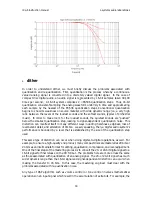
rdq-6 instruction manual
z-systems audio laboratories
19
internal result of the rdq-6’s volume control is, in general, 40 bits, whereas the CD source
material feeding it is only 16 bits. Ideally, we would like to present the digital-to-analog
converter (DAC) with a signal having the proper bit-width. For today’s 20-bit converters, we
need to somehow “map” the 40 internal bits to a 20-bit result that can be used by the
converter. How we do this can impact the sound dramatically. In fact, one of the keys to
successful audio DSP is dealing with the accumulated extra bits.
This is where dither comes in. Dither is an extremely low-level signal that is used to
ameliorate some of the sonically disturbing effects of quantization or re-quantization. There
are many different “flavors” of dither, all of which have their own strengths and weaknesses.
In its simplest form, dither is a very small noise signal that is added to the original signal
before quantization or re-quantization. The net result of dither is to decorrelate the
quantization or re-quantization error from the signal itself, which helps improve the low-level
characteristics of the system. It may seem paradoxical that the key to eliminating digital
distortion is through the addition of noise, but this is indeed the case. Dither will increase the
system’s overall noise level, but the resulting noise floor is much more like an analog noise
floor. Interestingly, in a properly dithered system signal details far smaller than the smallest
quantization step can be heard, giving an effective dynamic range well beyond the 96 dB
commonly attributed to the compact disc medium. This has profound sonic implications,
including but not limited to timbral neutrality, stereo image, and reverberant detail. Judicious
use of dither is one of the keys to the rdq-6’s unrivaled sonic performance.
Let’s look at a simple example. Figure 20 shows the spectrum of a 40-bit 5512 Hz sine wave
sampled at 44.1 kHz, with an amplitude of –96 dB from full-scale digital. Notice that all of the
signal’s power is concentrated at the frequency of the fundamental: 5512 Hz. There is actually
a small amount of power across the rest of the audio band due to the quantization to 40 bits,
but it is well below –160 dB in magnitude.
F
IGURE
20
What happens when we convert the 40-bit sine wave to a 16-bit sine wave by means of
truncation (that is, by throwing away the lower-order bits)? Figure 21 shows the spectrum of













































